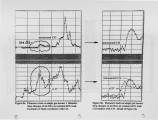| OCR Text |
Show these correlations were unsatisfactory. We eventually discovered that a combination of these signals into a new calculated value ( signal No. 17) led to the impressive result shown in Fig. 6. Figures 7 and 8 (the same combination in other tests and at different loads) show the same graphs for different tests and different loads. Figure 8b shows an amplified detail of Figure 8a; it illustrates the good correlation between our discovered calculated value (No. 17) and measured CO. These figures also show that we did not always receive such close correlations with CO (as in Figure 6), We attribute this to the specific drawbacks of the CO analyzer used. This instrument was slow and often provided inconsistent and nonrepeatable readings (due to its design features related to signal saturation and consequtive purging). Type 3 Signal. We succeeded in forming an acceptable Type 3 signal. This signal was a combination of several signals that provide good correlation with burner load. Figure 9 shows various combinations of these signals. Based on this analysis, we developed an algorithm which provides good linear correlation with load for this particular gas burner. Type 4 Signal. We identified an essentially different class of nonlinear signals, the so-called Ssignals, which provide consistent, repeatable, and reliable response to any flame disturbance, changes of load, or excess air (Figure 10). Conclusions and Recommendations Burner Diagnostic System testing at the Fireye combustion facility has brought us to the following conclusions. • Fireye tests have yielded unparalleled results that demonstrate that the BDS can be used for practical applications. This new system is an effective tool for combustion diagnostics. It generates an array of calculated statistical values that correlate with vital combustion parameters, including air flow, NOx, burner load, gaseous combustibles, and flame stability. • Specific algorithms used on the tested gas burner need further testing on a scaled-up gas burner and on other types of burners and fuels. References: 1. Khesin. MJ., "Combustion Diagnostics based on Frequency Spectra Analysis", American Flame Research Committee, Monterey, CA, October, 1995. 2. Khesin MJ.,"Demonstration of New Frequency-Based Flame Monitoring System", American Power Conference, Chicago, April, 1996. 3. Khesin, M.J. et al, "Application of a Flame Spectra Analyzer for Burner Balancing", Sixth International ISAIEPRI Conference, Baltimore, June, 1996. 5 |

















